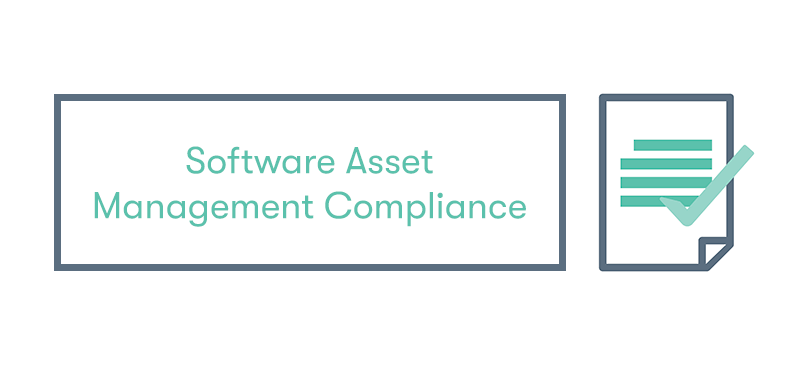Software Asset Management Compliance
Welcome to our exploration of Software Asset Management (SAM) Compliance, a cornerstone in the modern IT landscape. Managing these assets effectively has become paramount in this digital era, where software drives almost every aspect of business operations.
SAM Compliance isn't just about adhering to legal requirements; it's a strategic approach that aligns software investments with business goals, optimises costs, and mitigates risks. As organisations navigate complex software licensing agreements and evolving regulations, understanding the nuances of SAM Compliance becomes crucial.
This blog aims to demystify SAM Compliance, offering insights into its importance, the implications of ISO/IEC 19770 standards, and practical strategies for ensuring compliance. Join us as we delve into the world of SAM Compliance, an essential element for maintaining legal, financial, and operational integrity in today's technology-driven business environment.
What is Compliance for Software Asset Management (SAM)?
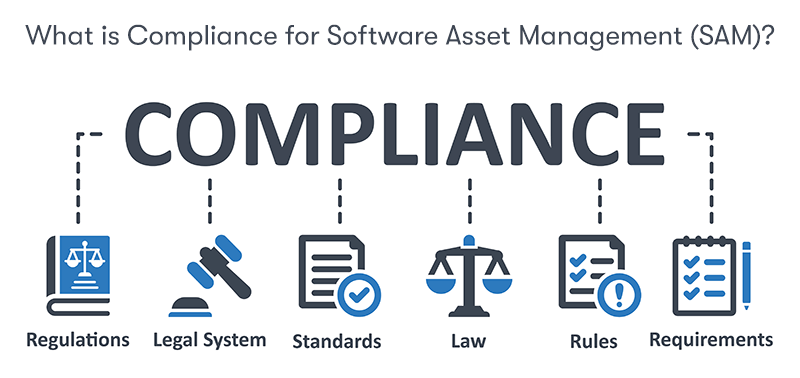
Compliance in Software Asset Management refers to ensuring that software within an organisation is used and managed per various legal, regulatory, and contractual requirements. It involves several key aspects:
License Compliance
This is about ensuring that all software used in the organisation is properly licensed. It involves verifying that the number of installations and users of software do not exceed the terms agreed upon in the software licenses.
Regulatory Compliance
This involves adhering to laws and regulations that pertain to software use. Different industries and regions have specific regulations, such as data protection laws, which must be followed.
Contractual Compliance
Beyond licensing, organisations often have contractual obligations with software vendors or partners. These could include terms about how software is used, maintained, or supported.
Standard Compliance
Organisations may also need to comply with internal standards or industry best practices for software management. This can include using approved software versions, adherence to security protocols, and regular audits.
Audit Preparedness
Part of compliance is being ready for software audits. This means having a clear and accurate record of software assets, licenses, usage and being able to produce these records on demand.
Cost Management
While not strictly a compliance issue, effective SAM ensures that the organisation is not paying for unused or unnecessary software licenses, which is often a part of broader compliance strategies.
Risk Management
Ensuring compliance in software asset management also helps mitigate risks associated with legal actions, financial penalties, and reputational damage that can arise from non-compliance.
In essence, compliance in SAM is about ensuring that software is used legally, ethically, and efficiently within an organisation. This requires a combination of good record-keeping, regular audits, and ongoing management of software assets.
Why is Software Asset Management Compliance Important?
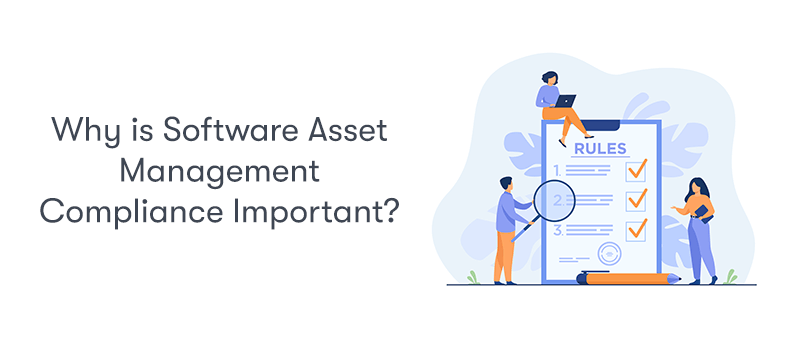
Software Asset Management Compliance is important for several key reasons, each contributing to the operational, financial, and legal health of an organisation:
Legal Protection
Non-compliance with software licenses can lead to legal issues, including lawsuits and fines. Ensuring compliance helps avoid legal penalties and the associated costs and reputational damage.
Cost Savings and Optimisation
Effective SAM compliance helps identify underutilised or unnecessary software licenses, allowing an organisation to avoid overspending on software. It also helps negotiate more favourable terms with vendors when actual usage data is available.
Risk Management
Compliance reduces the risk of security vulnerabilities. Using unlicensed or outdated software can expose an organisation to security risks, including malware and data breaches. Ensuring that all software is licensed correctly and up to date mitigates these risks.
Audit Preparedness
Regular compliance checks prepare an organisation for external audits by software vendors or regulatory bodies. Being audit-ready can significantly reduce the stress and potential financial impacts of these events.
Regulatory Compliance
Many industries are subject to specific regulatory requirements regarding data privacy, security, and other aspects of IT management. SAM compliance ensures adherence to these regulations, avoiding penalties and ensuring the integrity of business operations.
Operational Efficiency
Proper software asset management ensures the right tools are available to the right people, improving productivity and operational efficiency. It also helps in maintaining an organised and efficient IT environment.
Strategic Planning
SAM compliance data can inform strategic decisions about IT investments and resource allocation. Understanding software usage patterns and needs helps in making informed decisions about future investments.
Enhanced Vendor Relationships
Compliance with software licensing terms contributes to a positive relationship with vendors, which can be beneficial in negotiations, obtaining better support, and having access to more favourable pricing or terms in the future.
Corporate Governance and Reputation
Compliance with software licensing is part of good corporate governance. It demonstrates a commitment to ethical practices, which can positively influence an organisation's reputation with stakeholders, including customers, partners, and employees.
In summary, SAM compliance is vital for maintaining legal and ethical standards, optimising costs, managing risks, ensuring operational efficiency, and contributing to an organisation's overall strategic and governance framework.
What is ISO-19770? How Does it Relate to SAM Compliance?
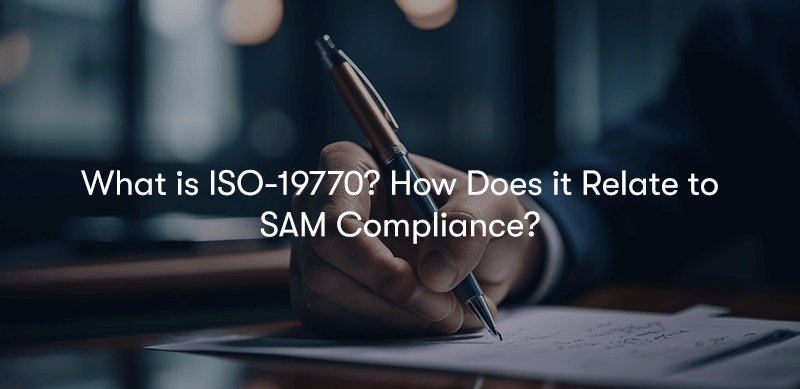
ISO/IEC 19770 is a series of international standards focusing on Software Asset Management. These standards provide a framework for organisations to manage their software assets effectively. The standards in this series are designed to help organisations control and protect their IT assets, ensure legal and regulatory compliance, and optimise costs associated with software. Key aspects of ISO/IEC 19770 include:
ISO/IEC 19770-1
This is the leading standard in the series and outlines best practices for implementing a SAM system. It provides a framework for establishing, implementing, maintaining, and improving SAM within an organisation. ISO/IEC 19770-1 is designed to be applicable to organisations of all sizes and types.
ISO/IEC 19770-2
This part of the standard focuses on software identification tags. These tags provide a standardised way to identify software, making managing and controlling software assets easier. The tags contain essential information about software components, aiding inventory management and compliance checking.
ISO/IEC 19770-3
This section deals with the entitlement schema, which helps organisations manage their software licenses. The entitlement schema provides a standardised format for software license information, facilitating easier license management and compliance.
ISO/IEC 19770-4
This part of the series focuses on resource utilisation measurement. It provides a standard for collecting, managing, and reporting on the usage of software and related resources. This is important for optimising software usage and cost.
ISO/IEC 19770 and SAM Compliance
Framework for SAM
ISO/IEC 19770 provides a comprehensive framework for establishing and maintaining an effective SAM program. It covers various aspects of SAM, including inventory management, license compliance, and risk management.
Best Practices
The standards represent best practices in the industry. Following these guidelines helps organisations ensure they are managing their software assets effectively and in line with internationally recognised practices.
Legal and Regulatory Compliance
By adhering to the ISO/IEC 19770 standards, organisations can better ensure compliance with legal and regulatory requirements related to software usage.
Cost Management
These standards help organisations manage software costs more effectively by providing guidelines for software procurement, usage, and optimisation.
Risk Mitigation
Following ISO/IEC 19770 standards helps identify and mitigate risks associated with software assets, such as the use of unauthorised software or non-compliance with licensing agreements.
In summary, ISO/IEC 19770 is crucial for SAM compliance as it provides a structured approach and industry best practices for managing software assets efficiently and effectively. By adhering to these standards, organisations can ensure legal compliance, optimise software costs, and reduce risks associated with software asset management.
How Can You Ensure You Are in Compliance with SAM?
Ensuring compliance in Software Asset Management involves a multi-step approach that requires continuous monitoring, management, and adjustment. Here are key steps to ensure SAM compliance:
Conduct a Software Inventory
Start by conducting a thorough inventory of all the software used across the organisation. This should include details about the software, versions, and the number of installations. It's important to use automated tools to ensure accuracy and efficiency.
Review Software Licenses
Collect and review all software licenses to understand the terms and conditions, including the number of allowed users or installations, usage rights, and restrictions. This information should be accurately recorded and regularly updated.
Implement a SAM Tool
Utilise specialised SAM tools to automate many aspects of software asset management. These tools can help track software usage, manage licenses, and alert when compliance issues arise.
Establish SAM Policies and Procedures
Develop clear policies and procedures for purchasing, deploying, using, and retiring software. These policies should be aligned with industry best practices and regulatory requirements.
Regular Audits and Compliance Checks
Conduct regular internal audits to ensure compliance with software licensing agreements and regulatory requirements. This should include checks for unauthorised software and verification that the software used complies with the licensing terms.
Employee Training and Awareness
Train employees on the importance of SAM compliance. They should understand the legal and financial implications of non-compliance and be aware of the organisation's policies regarding software usage.
Manage Software Requests and Usage
Establish a controlled process for software requests, approvals, and installations. This helps to prevent the use of unauthorised or unlicensed software.
Monitor and Manage Changes
Continuously monitor software usage and manage changes in the IT environment. This includes keeping track of new software installations, updates, and removals.
Vendor Management and Negotiations
Regularly communicate with software vendors. This can help in understanding compliance requirements and also in negotiating terms that are favourable and aligned with actual usage patterns.
Prepare for External Audits
Be prepared for external software audits by vendors or regulatory bodies. This includes maintaining accurate records of software purchases, licenses, deployment, and usage.
Update SAM Practices Regularly
The IT environment is dynamic, with new software and technologies emerging regularly. It's important to periodically review and update SAM practices to ensure they remain effective and compliant with the latest standards and regulations.
By following these steps, organisations can establish a robust SAM compliance program that minimises legal and financial risks, optimises software investments, and supports operational efficiency.
What Is Software License Compliance?
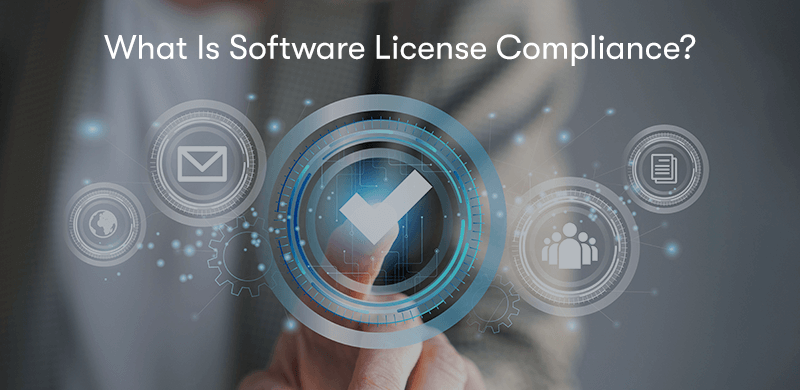
Software license compliance refers to the practice of using software in accordance with the terms and conditions outlined in its license agreement. This is a critical aspect of Software Asset Management and involves several key elements:
Adhering to License Terms
Every software comes with a license that specifies how it can be used. This can include limitations on the number of users, installations, geographical location, type of use (commercial vs. non-commercial), and more. Compliance means ensuring that the software is used within these terms.
Avoiding Unauthorised Use
This involves ensuring that the software is not copied, distributed, or used in ways that are not permitted by the license. Unauthorised use can lead to legal penalties and reputational damage.
Regular Auditing and Monitoring
Keeping track of software installations and usage across an organisation to ensure they align with the purchased licenses. This often involves regular audits and the use of software inventory tools.
License Optimisation
This involves staying compliant and ensuring that you are not over-licensed; that is, paying for more licenses than you need. It's about finding a balance between compliance and cost-efficiency.
Updating Licenses
Ensuring that software licenses are kept up to date, particularly in the context of renewals, upgrades, or changes in the organisation that might affect the licensing requirements (like company expansion, downsizing, or shifts in technology use).
Educating Employees
All employees must be aware of the importance of software license compliance and understand the policies and procedures that the organisation has put in place to ensure it.
Preparation for Vendor Audits
Software vendors may conduct audits to check if their customers comply with the licensing terms. Preparing for these audits involves maintaining clear, accurate records of software purchases, deployments, and usage.
Legal and Financial Ramifications
Non-compliance can result in legal actions, financial penalties, and damage to the organisation's reputation. Therefore, managing software license compliance is critical to avoid these risks.
In summary, software license compliance is about legally and ethically using software in accordance with the licensing agreements. It involves careful management, regular auditing, and an organisation-wide understanding of the importance of adhering to software licenses. This not only helps in avoiding legal and financial penalties but also in optimising software expenditures.
Final Notes on SAM Compliance
In conclusion, our exploration of Software Asset Management and compliance has highlighted its critical role in modern organisations. We delved into the importance of SAM compliance, including legal protection, cost optimisation, and risk management. We discussed ISO/IEC 19770 standards, emphasising their framework for effective software management. Strategies to ensure SAM compliance, like conducting software inventories and regular audits, were also outlined.
Moreover, we defined software license compliance, underscoring adherence to licensing terms and avoiding unauthorised use. These insights are invaluable for organisations seeking to navigate the complexities of software management efficiently and legally.
Embracing these practices ensures legal and financial security and fosters an environment of operational excellence and ethical responsibility in the digital age.


